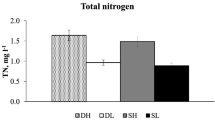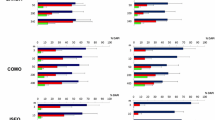Abstract
Ciliate and bacterial densities and their link with eutrophication were studied in fourteen shallow lakes in northwest Spain. Total phosphorus (TP) in these lakes varied between 30 μg l−1 and 925 μg l−1 and chlorophyll a concentration (chla) between 0.5 μg l−1 and 107 μg l−1. Bacterial abundance ranged from 1 × 106 to 14 × 106 cells ml−1, while ciliate abundance ranged from 0.6 cells ml−1 to 229 cells ml−1. Lakes were classified into three trophic types from their TP and chla concentrations. Bacterial abundance was significantly correlated with trophic type, as well as with TP and with chla separately, whereas ciliate abundance was only correlated with chla. No significant relationship could be established between bacterial and ciliate abundance across the trophic gradient. A general pattern was observed in the ratios of bacterial abundance to TP and chla concentrations, of decreasing ratios with increases in the nutrient loading. This pattern was not found for ciliates. The dominant zooplankton group in 13 of the 14 lakes studied was Rotifera, which accounted for a mean of 71% of total zooplankton abundance (41% of zooplankton biomass). The positive correlation between bacteria and ciliates with this group, and the absence of any relationship with Cladocera suggest that top down control by cladocerans was weaker in our lakes than previously shown in northern European shallow lakes. Rotifers could be important predators of bacteria in the high-nutrient lakes of our study. Higher slopes of regressions on bacterial abundance towards the hypertrophic range indicate that top-down control was weaker in our lakes than in northern European shallow lakes.





Similar content being viewed by others
References
Adrian, R., 1991. The feeding behaviour of Cyclops kolensis and C. vicinus (Crustacea, Copepoda). Verhandlungen Internationale Vereinigung für Theoretische und Angewandte Limnologie 24: 2852–2863.
Arndt, H., 1993. Rotifers as predators on components of the microbial web (bacteria, heterotrophic flagellates, ciliates) – a review. Hydrobiologia 255/256: 231–246.
Arvola, L., 1981. Spectrophotometric determination of chlorophyll a and phaeopigments in ethanol extraction. Annales Botanici Fennici 18: 221–227.
Auer, B., U. Elzer & H. Arndt, 2004. Comparison of pelagic food webs in lakes along a trophic gradient and with seasonal aspects: influence of resource and predation. Journal of Plankton Research 26: 697–709.
Azam, F., T. Fenchel, J. G. Field, J. S. Gray, L. A. Meyer-Reil & T. F. Thingstad, 1983. The ecological role of water-column microbes in the sea. Marine Ecology Progress Series 10: 257–263.
Berninger, U. G., B. J. Finlay & P. Kuuppo-Leinikki, 1991. Protozoan control of bacterial abundances in freshwaters. Limnology and Oceanography 36: 139–147.
Bettarel, Y., T. Sime-Ngando, C. Amblard, J. F. Carrias & C. Portelli, 2003. Virioplankton and microbial communities in aquatic systems: a seasonal study in two lakes of differing trophy. Limnology and Oceanography 48: 810–822.
Biddanda, B., M. Ogdahl & J. Cotner, 2001. Dominance of bacterial metabolism in oligotrophic relative to eutrophic waters. Limnology and Oceanography 46: 730–739.
Burns, C. W. & M. Schallenberg, 1996. Relative impacts of copepods, cladocerans and nutrients on the microbial food web of a mesotrophic lake. Journal of Plankton Research 18: 683–714.
Cotner, J. B. & R. G. Wetzel, 1992. Uptake of dissolved inorganic and organic phosphorus compounds by phytoplankton and bacteria. Limnology and Oceanography 37: 232–243.
Cotner, J. B. & B. A. Biddanda, 2002. Small players, large role: microbial influence on biogeochemical processes in pelagic aquatic ecosystems. Ecosystems 2: 105–121.
Fernández-Aláez, C., M. Fernández-Aláez & E. Bécares, 1999. Influence of water level fluctuation on the structure and composition of the macrophyte vegetation in two small temporary lakes in the northwest of Spain. Hydrobiologia 415: 155–162.
Fernández-Aláez, M., C. Fernández-Aláez, E. Bécares, M. Valentín, J. Gomá & P. Castrillo, 2004. A two-year experimental study on nutrient and predator influences on food webs constituents in a shallow lake of north west Spain. Freshwater Biology 49: 1574–1592.
García-Criado, F., E. Bécares, C. Fernández-Aláez & M. Fernández-Aláez, 2005. Plant associated invertebrates and ecological quality in some Mediterranean shallow lakes: implications for the application of the EC Water Framework Directive. Aquatic Conservation: Marine and Freshwater Ecosystems 15: 31–50.
Gasol, J. M. & C. M. Duarte, 2000. Comparative analyses in aquatic microbial ecology: how far do they go?. FEMS Microbiology Ecology 31: 99–106.
Grasshoff, K., M. Ehrhardt & K. Kremling, 1983. Methods of seawater analysis. Verlag Chemie, Weinheim.
Jack, J. D. & J. J. Gilbert, 1997. Effects of metazoan predators on ciliates in freshwater plankton communities. Journal of Eukaryotic Microbiology 44: 194–199.
Jeffrey, S. W. & G. C. Humphrey, 1975. New spectrophotometric equations for the determination of chlorophylls-a, b, c1 and c2 in higher plants, algae and natural phytoplankton. Biochemie und Physiologie der Pflanzen 167: 191–194.
Jeppesen, E., O. Sotkjaer, M. Sondergaard & M. Erlandsen, 1992. Impact of a trophic cascade on heterotrophic bacterioplankton production in two shallow fish-manipulated lakes. Archiv fur Hydrobiologie 37: 219–231.
Jeppesen, E., M. Sondergaard, J. P. Jensen, E. Mortensen & O. Sortkjaer, 1996. Fish-induced changes in zooplankton grazing on phytoplankton and bacterioplankton: a long term study in shallow hypertrophic Lake Sobygaard. Journal of Plankton Research 19: 1605–1625.
Jeppesen, E., M. Erlandsen & M. Sondergaard, 1997. Can simple empirical equations describe the seasonal dynamics of bacterioplankton in lakes: an eight-year study in shallow hypertrophic and biologically highly dynamic lake Sobygard, Denmark. Microbial Ecology 34: 11–26.
Jeppesen, E., M. Sondergaard, J. P. Jensen, E. Mortensen, A. M. Hansen & T. Jorgensen, 1998. Cascading trophic interactions from fish to bacteria and nutrients alter reduced sewage loading: an 18-year study of a shallow hypertrophic lake. Ecosystems 1: 250–267.
Jezbera, J., J. Nedoma & K. Šimek, 2003. Longitudinal changes in protistan bacterivory and bacterial production in two canyon-shaped reservoirs of different trophic status. Hydrobiologia 504: 115–130.
Jürgens, K., O. Skibbe & E. Jeppesen, 1999. Impact of metazooplankton on the composition and population dynamics of planktonic ciliates in a shallow, hypertrophic lake. Aquatic Microbial Ecology 17: 61–75.
Jürgens, K. & E. Jeppesen, 2000. The impact of metazooplankton on the structure of the microbial food web in a shallow, hypertrophic lake. Journal of Plankton Research 22: 1047–1070.
Mackereth, F. J. H., J. Heron & J. F. Talling, 1978. Water analysis: some revised methods for limnologists. Freshwater Biological Association. Scientific publication No. 36.
Moss B., D. Stephen, C. Álvarez, E. Bécares, W. J. Van de Bund, S. E. Collings, E. Van Donk, E. De Eyto, T. Feldmann, C. Fernández-Aláez, M. Fernández-Aláez, R. J. M. Franken, F. García-Criado, E. M. Gross, M. Gyllström, L.-A. Hansson, K. Irvine, A. Järvalt, J.-P. Jensen, E. Jeppesen, T. Kairesalo, R. Kornijów, T. Krause, H. Künnap & A. Laas, et al., (49 authors), 2003. The determination of ecological status in shallow lakes – a tested system (ECOFRAME) for implementation of the European Water Framework Directive. Aquatic Conservation: Marine and Freshwater Ecosystems 13: 507–549.
Moss, B., D. Stephen, D. M. Balayla, E. Bécares, C. Fernández-Aláez, M. Fernández-Aláez, C. Ferriol, P. García, J. Goma, M. Gyllström, L.-A. Hansson, J. Hietala, T. Kairesalo, M. R. Miracle, S. Romo, J. Rueda, V. Russell, A. Stahl-Delbanco, M. Svensson, K. Vakkilainen, M. Valentin, W. J. Van de Bund, E. Van Donk, E. Vicente & M. J. Villena, 2004. Continental-scale patterns of nutrient and fish effects on shallow lakes: synthesis of a pan-European mesocosm experiment. Freshwater Biology 49: 1633–1649.
Pace, M. L. & J. J. Cole, 1994. Comparative and experimental approaches to top-down and bottom-up regulation of bacteria. Microbial Ecology 28: 181–193.
Pace, M. L. & D. Vaqué, 1994. The importance of Daphnia in determining mortality rates of protozoans and rotifers in lakes. Limnology and Oceanography 39: 985–996.
Pomeroy, L. R., 1974. The ocean’s food web, a changing paradigm. BioScience 24: 499–504.
Pomeroy, L. R. & W. J. Wiebe, 1988. Energetics of microbial food webs. Hydrobiologia 159: 7–18.
Porter, K. G. & Y. S. Feig, 1980. The use of DAPI for identifying and counting aquatic microflora. Limnology and Oceanography 25: 943–948.
Porter, K. G., 1996. Integrating the microbial loop and the classic food chain into a realistic planktonic food web. In Polis, G. A. & K. O. Winemiller (eds), Food webs. Integration of Patterns & Dynamics. Ed Chapman & Hall, NY, 51–59.
Riemann, B. & K. Christoffersen, 1993. Microbial trophodynamics in temperate lakes. Marine Microbial Food Webs 7: 69–100.
Sanders, R. W., D. A. Caron & U. G. Berninger, 1992. Relationships between bacteria and heterotrophic nanoplankton in marine and fresh waters – an inter-ecosystem comparison. Marine Ecology Progress Series 86: 1–14.
Šimek, K., J. Bobková, M. Macek, J. Nedoma & R. Psenner, 1995. Ciliate grazing on picoplankton in a eutrophic reservoir during the summer phytoplankton maximum: a study at the species and community level. Limnology and Oceanography 40: 1077–1090.
Šimek, K., J. Armengol, M. Comerma, J. C. García, T. H. Chrzanowski, M. Macek, J. Nedoma & V. Straškrabová, 1998. Characteristics of protistan control of bacterial production in three reservoirs of different trophy. International Review of Hydrobiology 83: 485–494.
Standard Methods for the examination of water, wastewater. 1985. Ed. APHA, Washington, D.C. 16th edn.
Utermöhl, H, 1958. Zur vervollkommung der quantitativen phytoplankton-methodik. Mitteilung Internationale Vereinigung fuer Theoretische unde Angewandte Limnologie 9: 1–38.
Weinbauer, M. G. & P. Peduzzi, 1995. Significance of viruses versus heterotrophic nanoflagellates for controlling bacterial abundance in the northern Adriatic Sea. Journal of Plankton Research 17: 1851–1856.
Weisse, T., H. Müller, R. M. Pinto-Coelho, A. Schweizer, D. Springmann & G. Baldringer, 1990. Response of the microbial loop to the phytoplankton spring bloom in a large prealpine lake. Limnology and Oceanography 35: 781–794.
Wommack, K. E. & R. R. Colwell, 2000. Virioplankton: viruses in aquatic ecosystems. Microbial and Molecular Biology Reviews 64: 69–114.
Acknowledgements
This work was funded by the European Community Project ECOFRAME (EVK1-CT-1999-00039). Authors want to thank Margarita Fernández-Aláez, Camino Fernández-Aláez, Cristina Álvarez, Saúl Blanco Lanza, Carlos F. Rodríguez and Benito Fuertes for their valuable assistance in the field and laboratory.
Author information
Authors and Affiliations
Corresponding author
Rights and permissions
About this article
Cite this article
Conty, A., García-Criado, F. & Bécares, E. Changes in bacterial and ciliate densities with trophic status in Mediterranean shallow lakes. Hydrobiologia 584, 327–335 (2007). https://doi.org/10.1007/s10750-007-0585-x
Issue Date:
DOI: https://doi.org/10.1007/s10750-007-0585-x




